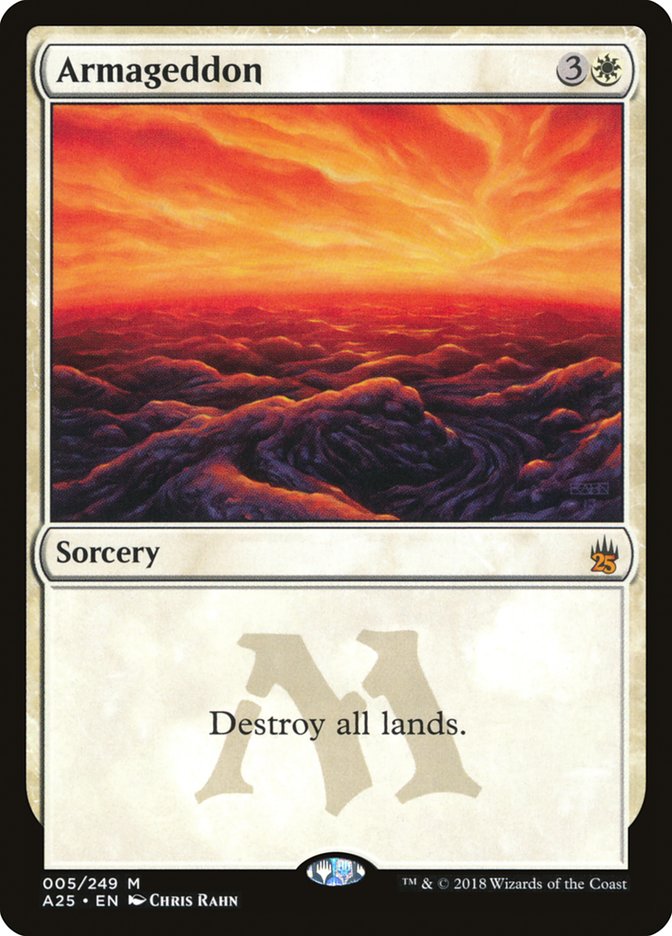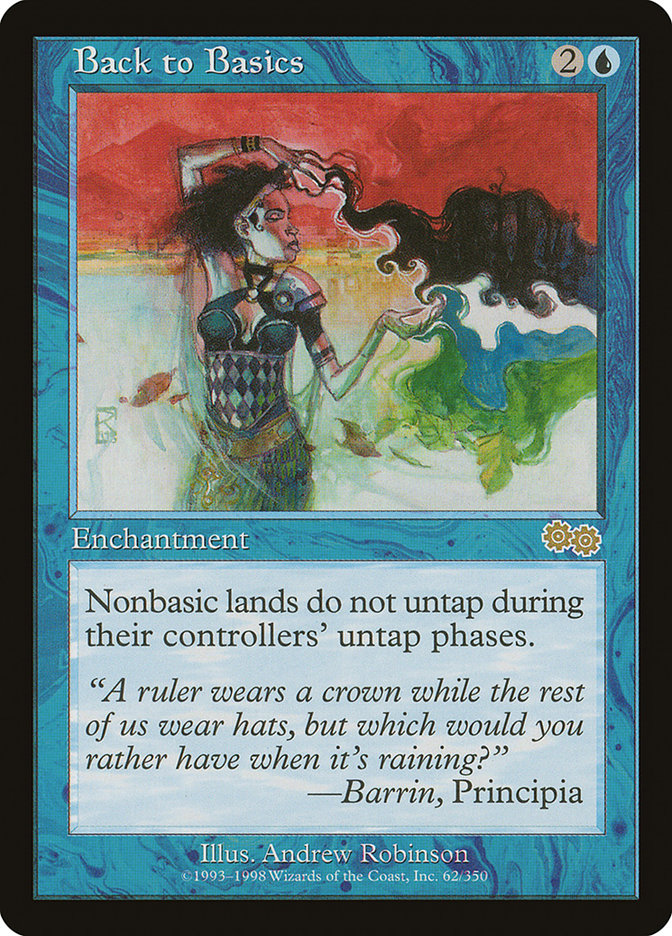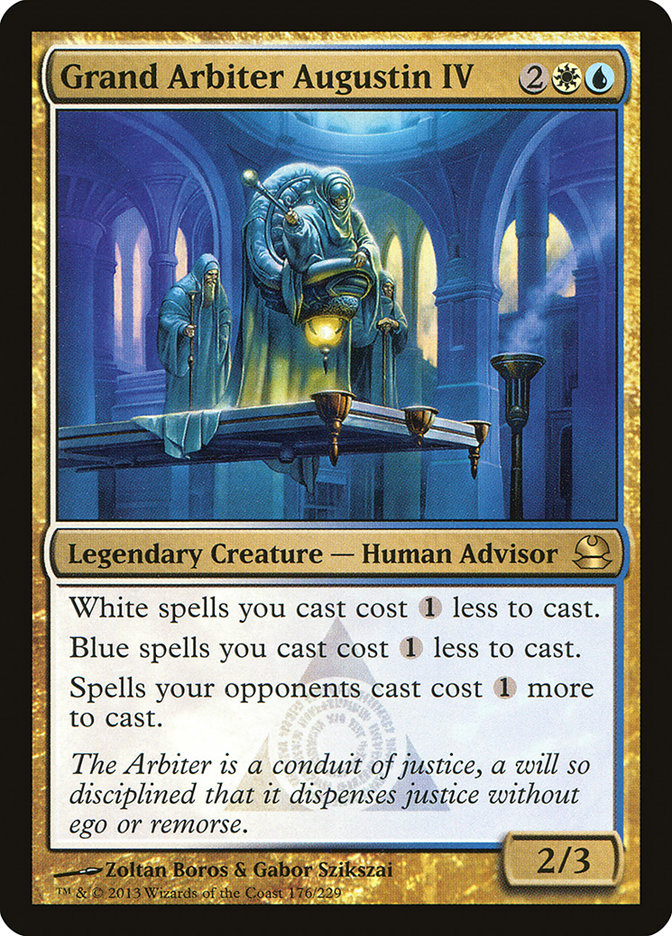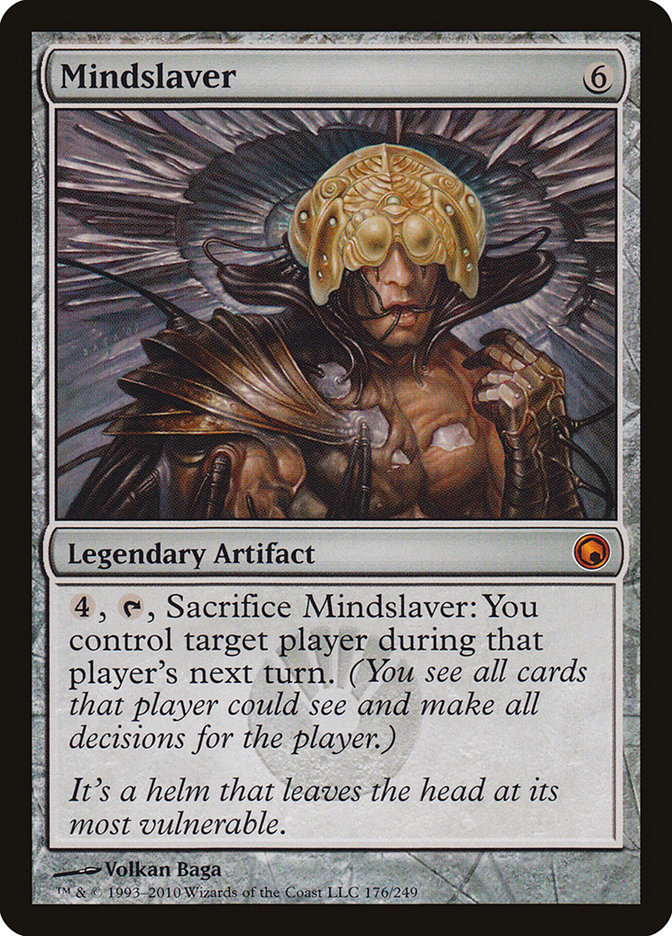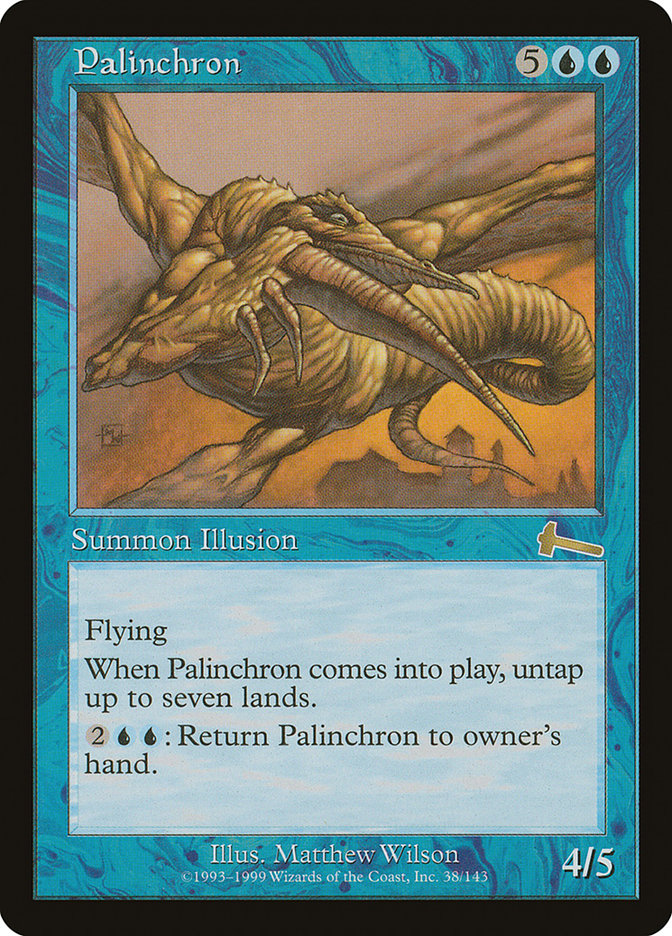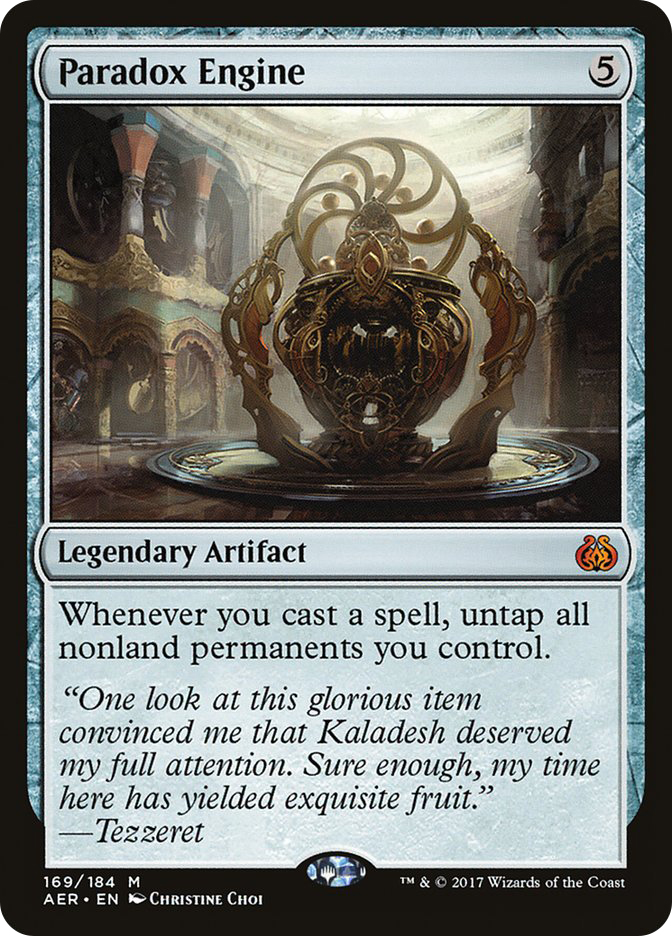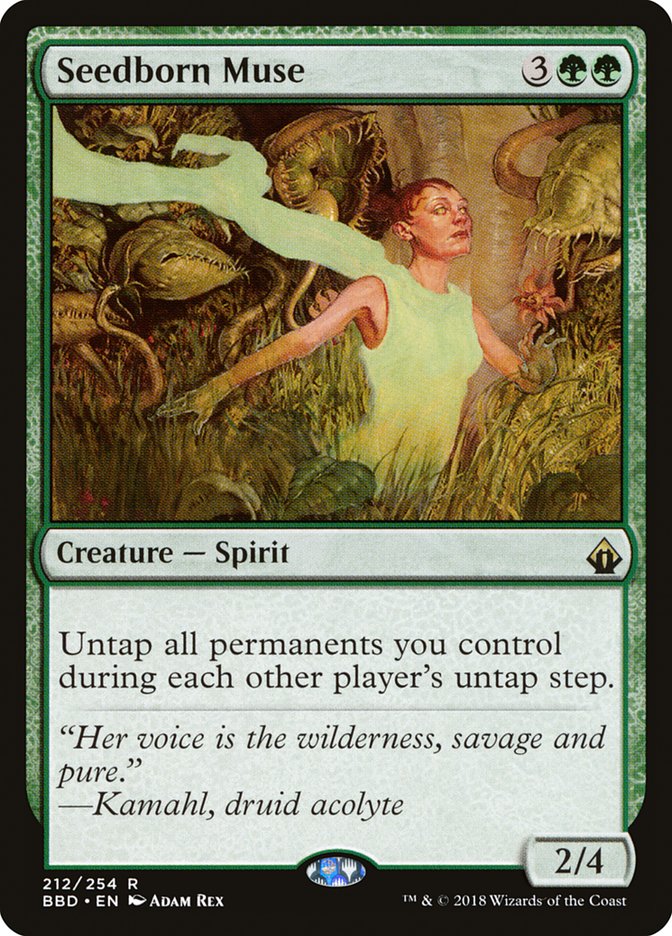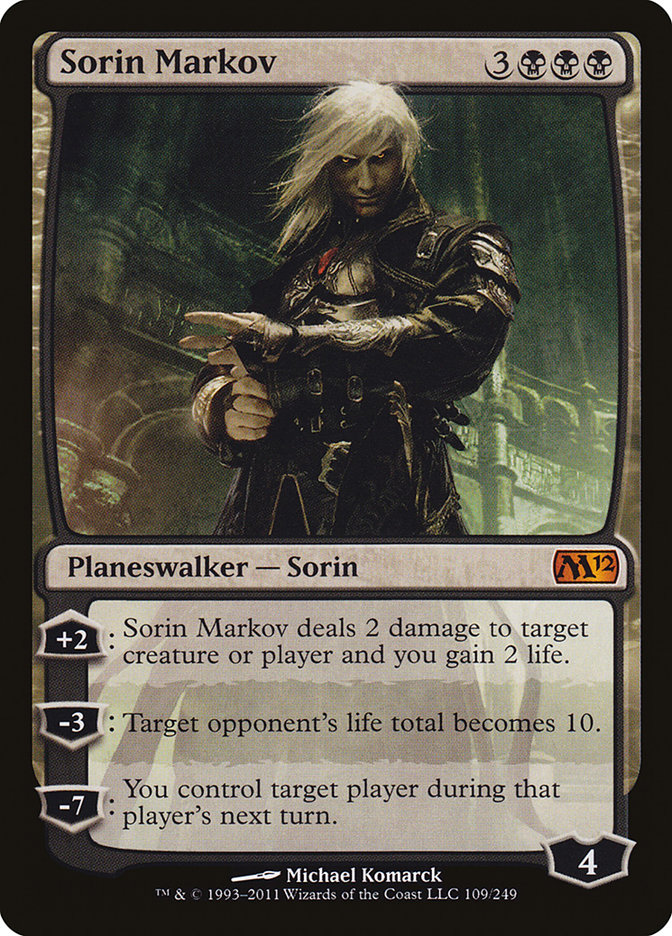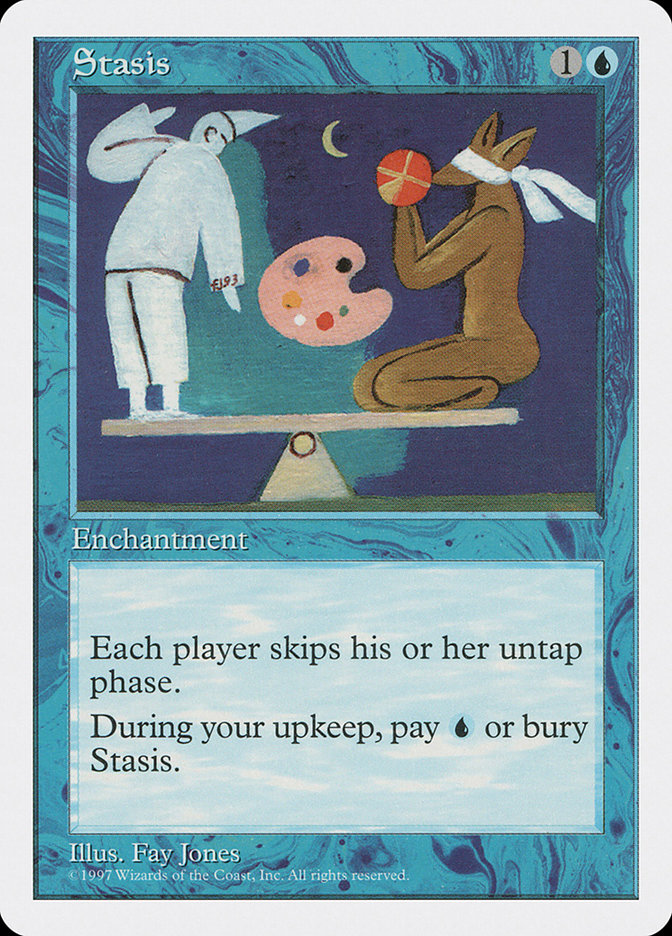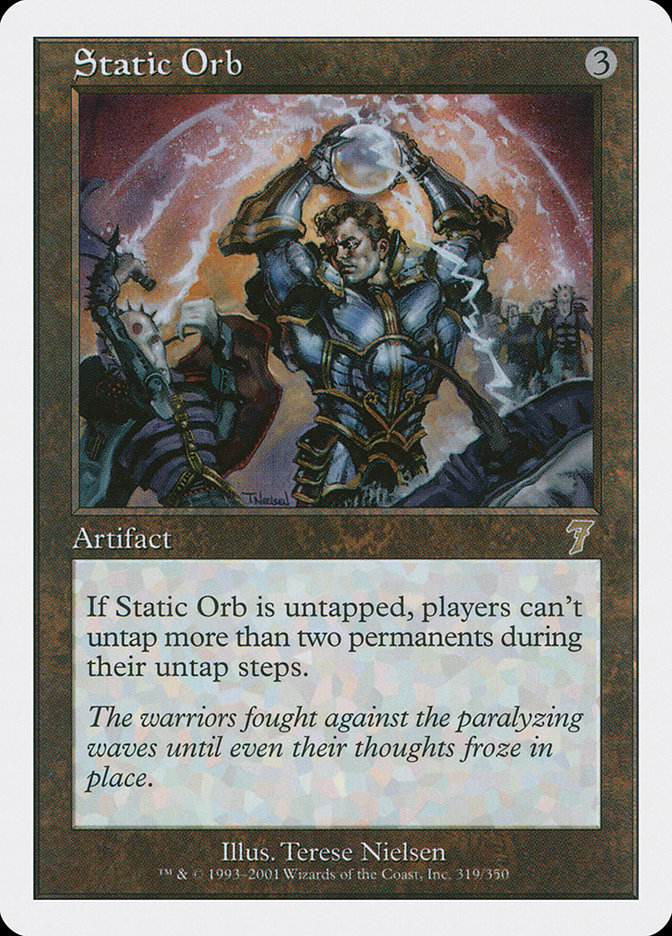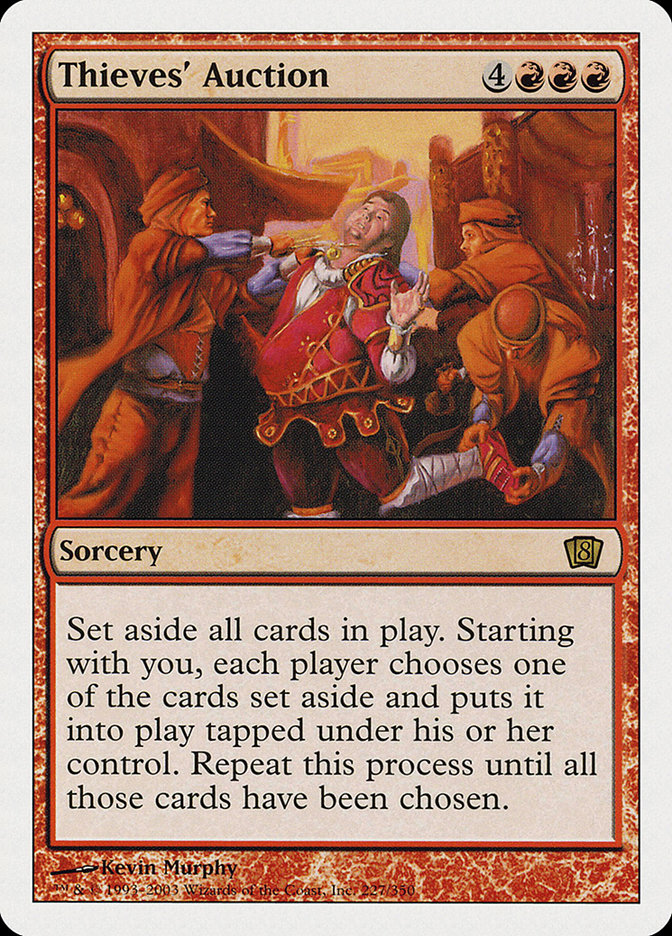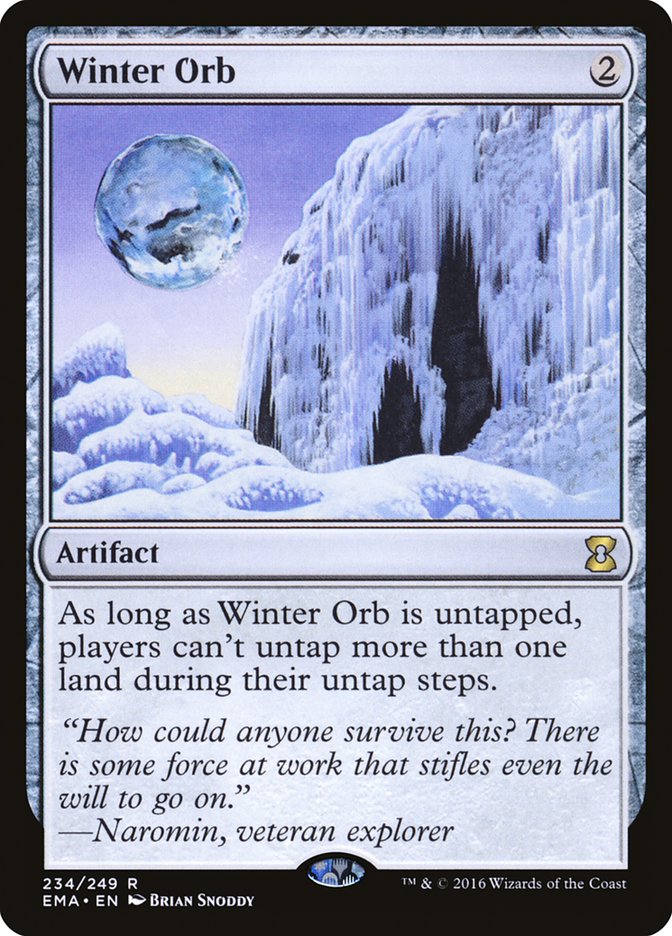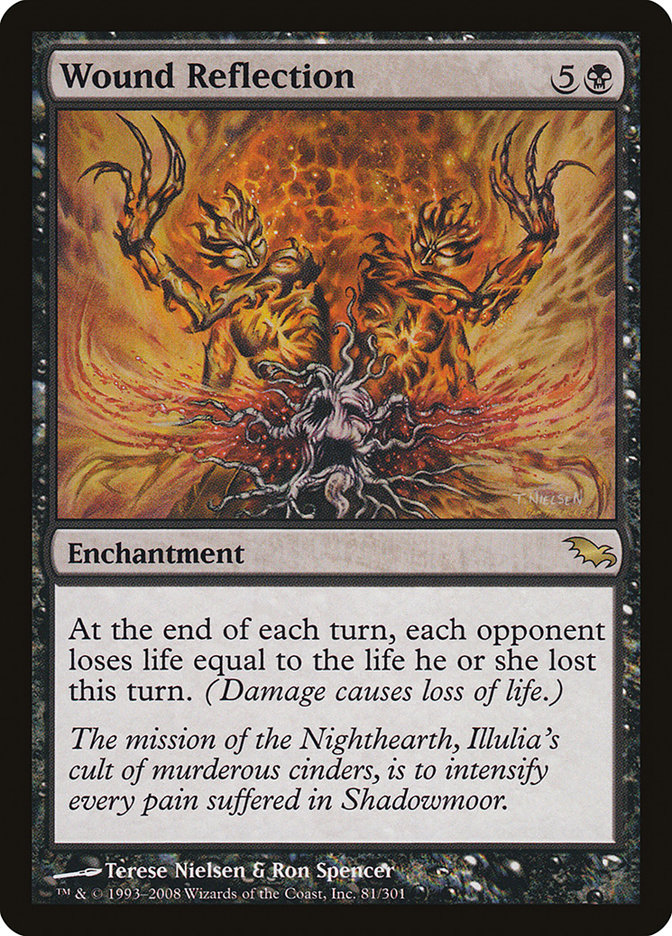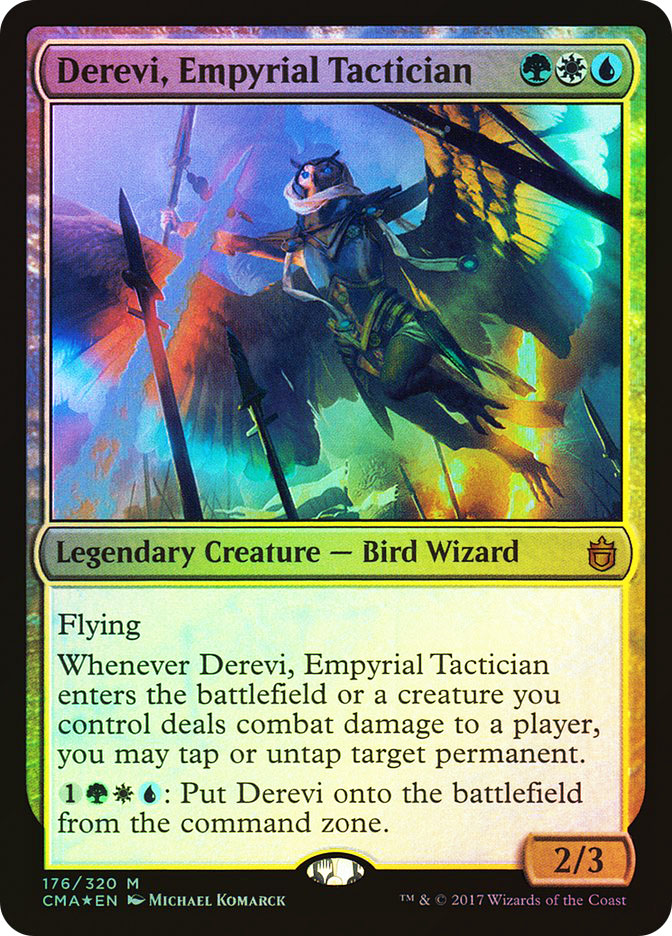We’ll start with a full confession: I don’t much like the word “should.” I
actually don’t believe in the concept of should. There is what is
and what is not. That doesn’t mean that everything which happens is good, but wishing a different result isn’t what should
have happened, but what we want to have happened. But this isn’t a
philosophical discussion, except for where it is absolutely a philosophical
discussion.
The first thing you’re going to ask is why I would then put should in the
title. The answer is simple: it’s effective shorthand. It’s also simply
provocative. The object of a title is to get you to read the rest; at least
for me, it’s not to get you to click on the article, but to actually
consume the entirety of it. I’d hate to disappoint you with a snappy title
and no follow-up.
The next thing you’re going to ask is why I wouldn’t just ban the cards I’m
going to list. There’s a two part answer here.
First of all, I’m not the only person on the Commander Rules Committee
(RC). Despite being the RC’s public face, I don’t get to decide
unilaterally what gets banned and unbanned. There are three other
highly-intelligent, deeply-experienced, zealously-committed people on the
Committee; we decided stuff as a team. The second part is a little more
involved.
A short, tight banned list is a good list. It’s easily messaged and people
can generally remember what’s on it without having to look it up. We on the
RC like to ban cards as exemplars as well. For a long time, our list
suggested that you also not play with “other cards like them.” We’ve
streamlined the wording to take away any confusion that the banned list is
merely a suggestion. If you want to play “official” Commander, the list is
clear.
The second part of the second part is that the Commander banned list is
crafted differently than the banned list for all other formats. Those
formats want the best possible tournament experience-balance, playability,
watchability, and so forth. Commander is created to create the best
possible social experience, so while a play style might not resonate with
me or the rest of the RC, it might be just what you like. We’d like to keep
as many of those avenues open to you as is reasonable. It bears repeating
that while we on the RC have a concept of what makes the best kind of games
for the broadest possible audience, we also have the idea that if a group
is all on the same page, whatever kind of game that resonates with them is
best.
What follows will be a reinforcement of the first part of the previous
sentence; they’re cards that we choose to not play with and would invite
you to consider the same. They’re listed alphabetically. The obvious common
thread is that these are cards which for the most part rob other players of
the opportunity to play the game. The rest are cards which are so awkward
that they deflate a game’s energy pretty quickly.
Armageddon
Armageddon represents a whole class of mass land destruction spells like
Obliterate, Jokulhaups, Decree of Annihilation, Impending Disaster, Myojin
of Infinite Rage, and more. I suppose there’s some wiggle room here for
playing Armageddon and its cousins as a “win now” card, but that seems more
like a strategy of making the game irritating so that everyone else will
just scoop. Said it before, I’ll say it again: we want to create games
you’ll always remember not ones you’d love to forget. I seriously doubt
anyone has ever played Armageddon and gotten an “oh, that’s so cool!”
response.
Back to Basics
This one’s tricky, because I believe in playing enough basic lands to make
sure that you don’t get wrecked by things like Back to Basics and
Ruination. I also believe that there should be some risk associated with
the flexibility of playing a bunch of lands which produce multiple colors
of mana. Having a sweet mana base is sweet, but it needs to come with a
cost (other than the $$$ you laid out for it). This one comes to a line,
because I’m also fine with playing cards like Price of Progress and
Anathemancer to punish players for getting too greedy with their mana
bases.
You might ask why Blood Moon isn’t on the list as well. The thing about
Blood Moon is that while it turns your dual lands into Mountains, it
doesn’t rob you of the mana. Unless you’ve been extremely greedy, then
you’re not out of the game, like with Back to Basics, you’re just slowed
down to some degree-which is equivalent with the risk you’ve taken.
Grand Arbiter Augustin IV
Grand Arbiter Augustin IV reminds me a little of Leovold, Emissary of
Trest. They put too many things together on one card. Had they just let
well enough alone and not put that third line on there, the card would be
fine. In fact, as an exemplar for the Azorius guild, it might be perfect.
How about doing legendary creatures for each guild that make spells of the
guild cost less? I might make them cost five instead of four, but then we
could probably get away with them having three power. Grand Arbiter costing
five would certainly not make it as bad, since the earlier it hits the
table, the more it slows down everyone else while accelerating its
controller. Grand Arbiter showing up on Turn 13 isn’t anywhere near as bad
as Turn 3. Taking away the early game from opponents is nearly like getting
an extra turn each time.
Mindslaver
I’m on record saying that one Mindslaver activation is probably okay, but
the people who are playing it are going to find a way to recur it, whether
that’s Academy Ruins or Sharuum the Hegemon. Mindslaver is that moderately
funny joke that gets a little less funny every time you tell it until
everyone starts rolling their eyes as soon as you start. Mindslaver is a
very Richard Garfield-esque card (I’ll cite both Word of Command in Alpha and having known him for a long time), and it’s not on a
terrible path, it’s just that the repeatability becomes problematic. If it
exiled itself, it probably wouldn’t be on this list. Cost is a different
story; it’d probably have to cost around 8 to cast and 8 to activate before
it might be safe enough. Obviously, it would have never gotten printed that
way.
Palinchron
Any time I see lands untapping on a card, I get a squicky feeling in the
pit of my stomach, because it seems like infinite combos aren’t far behind.
Because Palinchron provides a way to get it back into your hand and the
mana to cast it again, you don’t need that much to make it generate all the
mana you could ever want or need. The good news is we don’t see the card
accidentally wrecking games. You need your seventh land to produce eleven
mana to get started. It’s not all that difficult, with lands like Nykthos,
Shrine to Nyx, Gaea’s Cradle, and Cabal Coffers available in the format,
but there’s a level of intent that goes into building with Palinchron that
makes it reasonably safe.
Paradox Engine
Paradox Engine is the card on this list which stands the best chance of
coming up in an RC meeting. We’ve talked about it before and we’ll talk
about it again. We’re honestly a little divided on it at this point, with
the primary argument for not banning it being that it’s not broken until
you build around it; otherwise, it’s just value. The argument continues
that the only people who are going to break it aren’t the ones we’re
targeting with the format, which is why you continue to see cards that only
the competitive players abuse, such as Ad Nauseum or Hermit Druid, not on
the banned list. The counter argument is that it just leads to brokenness
because of the untapping. You don’t really need to build around it much
besides a few mana rocks, and you can go infinite pretty easily, which we
find not really good for the format. Having to assemble some seven piece
Rube Goldberg device to go infinite is fine, since it’s not going to happen
too early in a game and not too often in any case; too fast and easy
becomes problematic. I’m not going to say specifically who on the RC is on
which side of the debate, but just be aware it’d getting discussed.
Seedborn Muse
It’s not quite as bad as Prophet of Kruphix was because it doesn’t give you
the ability to cast creatures as though they had flash, but it’s still
pretty strong-and it gets stronger the more players there are in the game.
I’ll confess that I still play Seedborn Muse in one deck, Dreaming of
Intet, which is the deck I play when the gloves come off (although it’s
nowhere near what anyone could call competitive). It’s a card that I
definitely wouldn’t advise playing in a friendly game. It might not seem
all that bad while it’s getting played, but the incremental advantage it
provides is significant, and at some point you just dominate the game-if
not tactically, then in eating up all the play time.
Sorin Markov
People will argue that Sorin Markov is protection against rampant life
gain, but that’s not how we see it used. It’s about setting someone from
40-10 on Turn 5 or 6. The format already has protection against lifegain in
the guise of commander damage. If you’re not playing commanders which can
do 21, there are ways to still get around it. Axis of Mortality, Magus of
the Mirror, and Soul Conduit will get you there. Repay in Kind can be a
real beating if someone is extremely high and you’re extremely low.
Stasis
Nobody shows up at a Commander game running Stasis so that everyone has a
great time. In fact, it seems like a card that people play solely for the
purpose of intentionally irritating everyone else at the table. Most people
take losing as part of playing games; no one wants to sit down for their
limited amount of leisure time to be actively annoyed. Plus, it’s like the
most hideous art in the history of Magic.
Static Orb
Much like Stasis, it also has the awkward conditional clause “if Static Orb
is untapped,” meaning you can tap it at the end of turn of the player to
your right and be the only person who gets full untaps. Is this an effect
way to win the game? Absolutely. Is this an effective way in creating
memorable experiences? Absolutely not.
Thieves’ Auction
Thieves’ Auction is a card that seems like it’ll be loads of fun; in some
situations it actually might be, but that’s not my experience with the
card. You’ll do it with several dozen permanents on the battlefield and you
realize what drudgery the whole process will turn into, especially when you
have someone like me who’s going to take way too much time to decide what
to pick because I’m trying to think through the possibilities, getting
confused, and starting over again. Then, of course, there’s the mess at the
end of the game making sure everyone gets the correct cards back. Addendum:
Thieves’ Auction is probably a cool card to play in Commander Cube.
Winter Orb
Like Static Orb, it was the condition that you can tap it and be the only
one unfrozen. When you’re playing a social game, everyone would like to
participate instead of watching one person be the only one who can do
anything. Then that person also plays Kismet, Loxodon Gatekeeper, or Root
Maze, and the pace of the game becomes glacial. Again, we have an effective
way of winning a game which is also a terrible way to create a good game.
Wound Reflection
Wound Reflection is just one of those cards that creates bad feels. I could
argue that it ends up doing an amount of damage (well, life loss)
disproportional to its mana cost and that it affecting all opponents is way
too strong, but the part and parcel of this argument is that it just makes
other players feel bad. I get that we’re playing a game and that someone
has to win, but in Commander, the way you win is nearly as important as the
winning itself. You might say “well, not for me,” which is a fine and valid
stance, but you’re not the only person in the game, either. We want to
continue to reinforce the message that we’ve been projecting all along-a
Commander game is about everyone in it. Wound Reflection is a card that
takes players out of the game emotionally.
Bonus Commander: Derevi, Empyrial Strategist
Of all the legal commanders, Derevi is the one with too much stuff stapled
onto it. As we’ve already discussed, untapping things, especially land, can
get out of hand very quickly. Adding the “or a creature you control deals
combat damage to a player” was simply taking the design too far. Derevi’s
ability to circumvent the commander tax takes it way over the top. I
understand that it’s a quite serious competitive commander, which will make
anyone pause when they sit down across from you. I suspect no one is
playing Derevi just for the Bant colors; it’s more like Bant just makes the
card way more dangerous.
None of the cards listed above are going to by themselves ruin the format.
They are, however, representative of various classes of cards which create
games which are quite different from those we’re trying to encourage-ones
with plenty of multiple-player interaction in which the kinds of things
that happen make the whole table appreciate the game, whether they’re on
the winning end of it or not. In the end, everyone’s experience with the
format is their own; here’s hoping that when making some card choices, you
consider the experience of other people as well.
Question of the Week
From multiple sources: How’s your health?
I’m always humbled by the number of inquiries I get about how I’m doing.
This is an important week. As you’re reading this piece, I’ll be recovering
from surgery to remove a mass from my liver. It will be the toughest part
of the recovery. There’s 3-5 days in the hospital, then a long recovery at
home. The great news is that the surgeon is some sort of liver rock star,
so I have that going for me. I’m done with radiation treatments on my
throat already. While I’m starting to feel some of the aftereffects of the
treatments, the worst part of it will probably hit me while I’m in the
hospital for the other thing-which I suppose is better than having to
recover from one, then the other.
The short version is that I’m not feeling as bad as I did during my last
treatment, and I’m looking forward to coming out the other side in good
shape. Hopefully, I won’t miss any time discussing with all you fine folks
the greatest format in all of Magic.
Check out our comprehensive Deck List Database for lists of all my decks:
SIGNATURE DECKS
Purple Hippos and Maro Sorcerers
;
Kresh Into the Red Zone
;
Halloween with Karador
;
Dreaming of Intet
;
You Did This to Yourself
.
THE CHROMATIC PROJECT
Mono-Color
Heliod, God of Enchantments
;
Thassa, God of Merfolk
;
Erebos and the Halls Of The Dead
;
Forge of Purphoros
;
Nylea of the Woodland Realm
;
Karn
Evil No. 9.
Guilds
Lavinia Blinks
;
Obzedat, Ghost Killer
;
Aurelia Goes to War
;
Trostani and Her Angels
;
Lazav, Shapeshifting Mastermind
;
Zegana and a Dice Bag
;
Rakdos Reimagined
;
Glissa, Glissa
;
Ruric Thar and His Beastly Fight Club
;
Gisa and Geralf Together Forever
.
Shards and Wedges
Adun’s Toolbox
;
Angry, Angry Dinos
;
Animar’s Swarm
;
Borrowing Stuff at Cutlass Point
;
Ikra and Kydele
;
Karrthus, Who Rains Fire From The Sky
;
Demons of Kaalia
;
Merieke’s Esper Dragons
;
Nath of the Value Leaf
;
Queen Marchesa, Long May She Reign
;
Queen Marchesa’s Knights
;
Rith’s Tokens
;
The Mill-Meoplasm
;
The Altar of Thraximundar
;
The Threat of Yasova
;
Zombies of Tresserhorn
.
Four Color
Yidris: Money for Nothing, Cards for Free
;
Saskia Unyielding
;
Breya Reshaped
;
Yidris Rotisserie Draft Deck
.
Five-Color
Partners
Tana and Kydele
;
Kynaios and Tiro
;
Ikra and Kydele
.
THE DO-OVER PROJECT
Adun Oakenshield Do-Over
;
Animar Do-Over
;
Glissa Do-Over
;
Karador Do-Over
;
Karador Version 3
;
Karrthus Do-Over
;
Kresh Do-Over
;
Steam-Powered Merieke
Do-Over;
Lord of Tresserhorn Do-Over
;
Mimeoplasm Do-Over
;
Phelddagrif Do-Over
;
Rith Do-Over
;
Ruhan Do-Over
.
If you’d like to follow the adventures of my Monday Night RPG group (in a
campaign that’s been alive since 1987) which is just beginning the saga The Lost Cities of Nevinor, ask for an invitation to the Facebook
group “Sheldon Menery’s
Monday Night Gamers.”


